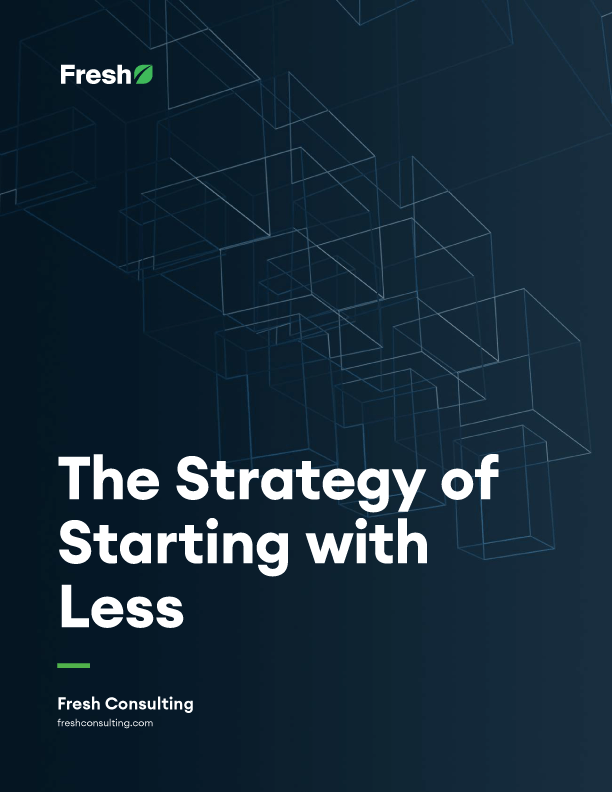Article
UI/UX Principle #10: Most People Don’t Get It Right the First Time

Being Bold
Innovation is exciting, but it can be treacherous.
In a post titled Vanguard, Dmitry Fadeyev argues that “It’s up to you whether you choose the steep rocky climb or the safe, well-trodden path, but that the former is riskier and more prone to failure does not make it a worse choice than the latter.” He continues, adding that “This is the path of the vanguard, the path of the designer prepared to suffer failure for the chance to lead [ . . . ] When they succeed, their work is celebrated as visionary.”
Fadeyev’s analysis taps into an important issue: design often involves risk if a designer wants to be at the leading edge of innovation. Some design problems demand risk taking, but more often than not, some variation of the problem has been previously encountered and some convention or best practice has been established in anticipation of how to deal with it.
The Value of Calculated Risks
The most important calculation in design is adding up whether or not a feature or functionality will act in service to a user’s goals, hence the importance of personas, user stories, and user flows. While adding a continuously self-randomizing navigation bar on a website could be interesting, it would make finding your way around the website incredibly difficult, and would thus negate the entire purpose of including a navigation system. This brings into focus the importance of balancing creativity and convention. Users want to be able to predict certain parts of their digital experience based on the conventions they have become accustomed to. This makes it easy, in terms of design, to get certain things right most of the time.
But if you calculate that an innovative feature or functionality could make a user’s life easier and allow them to more effectively accomplish their goal, then it’s worth pursuing. Keep in mind that risk is inherent to innovation, and that even if you abide by all of the standard design conventions, you won’t get it 100% right when it comes to experimentation.
Redefining Perfection
Technology is constantly changing. It’s nearly impossible to predict what trends will emerge in the future. Brave entrepreneurial spirits try new things and experiment with trying to establish new trends. But no one gets it right the first time. That’s why embracing the imperfection of experimentation is essential.
In a Dorm Room Tycoon interview with Jakob Nielsen, Nielsen states “We have never yet seen the perfect user interface. Don’t assume that your design is going to be the first one in the history of the universe to be the perfect user interface.”
If you change the location of an important button or CTA, there’s a reasonable chance it will confuse users and, subsequently, the integrity of the interface will be diminished (this is why usability testing is so important – see our blog post on why “A Little Bit of Usability Testing Goes a Long Way”). But without trying out an idea or testing a hypothesis, there’s no way to validate whether or not a new take on UI design could be more valuable than the established convention. This is one of the key reasons why we believe the UI/UX design process needs to be scientific and allow for hypothetical solutions to be designed and tested without always fully committing to development.
It’s important to prepare for the fact that no idea will be perfect, and even, that the majority of ideas won’t work at all. Dan McKinley, in a talk titled “Design for Continuous Experimentation” given while he was the principal engineer at Etsy, advised the audience to “Plan on not being right – a lot of the time – because your intuition about how your website works is not going to be completely in line with reality.”
Every idea that doesn’t work leads to a lesson – a valuable bit of information about how the next iteration of the idea can be improved upon. Instead of looking at failure as final, it’s important to view it as an integral part of eventually designing an experience that your customers love. If time is budgeted appropriately for user testing and ideas are tested consistently during the various design stages (wireframes, mockups, prototype), it’s easy to learn from mistakes and make a plan moving forward about how to get closer to that evasive but inspiring ideal of perfection.
Getting the Scientific UI/UX Process Right
At Fresh, we value the design and development process we’ve refined over the course of eight years. It will always be subject to change as we evolve, but we’ve focused on getting the ingredients of the process right in order to deliver the kind of high-quality experiences customers expect. While we might not find the perfect UI solution to a design problem in our first attempt, our process is built around that inevitability. Each design iteration helps us get closer to finding a solution that best accomplishes the user’s goals – something that we can put energy and focus into then developing for the next round of user testing.
Not expecting the perfect solution the first time is what allows designers to experiment and explore untested waters. Operating within UI conventions, with a healthy dose of risk for UX innovation, enables designers to create solutions that work.









